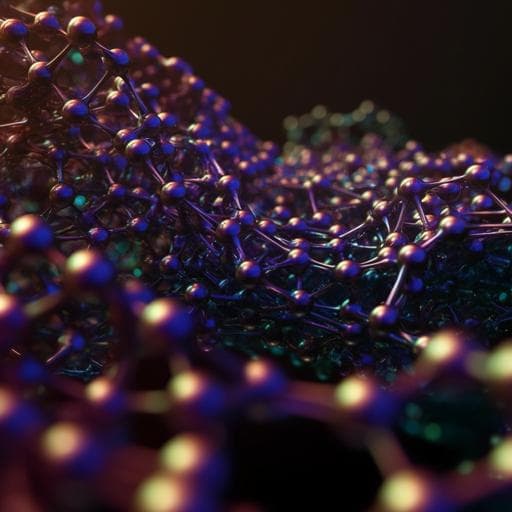
Engineering and Technology
Accelerated discovery of high-strength aluminum alloys by machine learning
J. Li, Y. Zhang, et al.
This study explores the innovative Al-Zn-Mg-Cu alloy system, achieving an impressive ultimate tensile strength of 952 MPa and 6.3% elongation through machine learning-based optimization. The research led by Jiaheng Li and colleagues showcases the potential of machine learning in advancing high-performance aluminum alloys.
~3 min • Beginner • English
Introduction
The study targets improving the mechanical strength of 7xxx (Al-Zn-Mg-Cu) alloys, which are widely used in aerospace and increasingly in rail transport. Commercial 7xxx alloys typically exhibit UTS below 700 MPa. Prior approaches to achieving ultra-high strength (>750 MPa) have included severe plastic deformation, rapid solidification/powder metallurgy, spray forming, and multistage heat treatments, but these often suffer from limitations such as scalability, complexity, and cost. Composition optimization within the broad, composition-sensitive 7xxx space presents an opportunity, especially given the role of main alloying elements (Zn, Mg, Cu) and trace additions (Zr, Ti, rare earths like Sc, Y, Ce). However, high Zn/Mg increase casting defects and corrosion susceptibility. Zr and Ti additions can introduce stable dispersoids, and rare-earth microalloying can refine grains and inhibit recrystallization, but cost (e.g., Sc) is an issue. The authors hypothesize that machine learning can accelerate discovery of high-strength, compositionally lean 7xxx alloys via efficient exploration of composition space and propose a modified Kriging-based efficient global optimization framework to identify alloys with targeted UTS.
Literature Review
Prior work shows ultra-high strengths in 7xxx alloys achieved through advanced processing: RS/PM and spray forming enable high alloying levels but face process complexity and scalability issues; SPD (e.g., HPT) yields >900 MPa but is not yet industrially practical. Alloy chemistry studies indicate high Zn and Mg (Zn>8 wt.%, Mg>2 wt.%) promote strength while elevating casting and corrosion problems. Zr is commonly used for grain refinement and recrystallization resistance; combined Zr+Ti forms more stable L12-Al3(Zr,Ti) dispersoids than Al3Zr. Rare-earth additions (Sc, Yb, Y, Ce, Gd) can refine grains and inhibit recrystallization, with Sc being most effective but costly, motivating exploration of cheaper REs (Y, Ce). Machine-learning-assisted materials design has been effective in other systems (e.g., adaptive design, active learning), with limited prior application to 7xxx alloys. This background motivates applying ML to efficiently optimize multicomponent 7xxx alloy compositions for strength using traditional processing routes.
Methodology
Machine-learning-assisted optimization: The authors define a search space AlxZnyMgzCuuTivYwCe with 5.1≤x≤8.4, 1.2≤y≤2.9, 0.8≤z≤2.6, 0.02≤u≤0.2, 0≤v≤0.5, 0≤w≤0.5 wt.%. Input features are alloy compositions; output is ultimate tensile strength (UTS). A training dataset of laboratory-fabricated alloys, all processed identically (solution treated and aged to assess ageing strengthening capacity), was compiled: 38 quaternary, 25 six-component, and 10 seven-component alloys. The ML surrogate is a Kriging model (DACE toolbox) with zero-order polynomial regression and Gaussian correlation; correlation parameters θ are optimized via a genetic algorithm (rather than pattern search) to avoid suboptimal fits. Model validation uses leave-one-out cross-validation with standardized residuals. Adaptive design loop: At each iteration, the “expected improvement” (EI) acquisition function guides selection of three new composition points (ensuring sufficient compositional separation for casting), computed via genetic algorithm. Iterations continue until EI falls below a threshold or a target UTS (550 MPa) is reached. Zr is intentionally excluded during composition optimization due to casting burn-off control challenges; after stopping, 0.2–0.25 wt.% Zr is added to the current-best alloy to form the optimized composition. Processing and characterization: All alloys for screening receive identical solution and ageing treatments. The optimized alloy is cast, homogenized (400 °C/12 h + 465 °C/24 h), extruded (~420 °C, ratio ~32, ram speed 0.4 mm/s), and heat treated under three conditions: ST6 (470 °C/2 h + RTWQ + 120 °C/24 h), DT6 [(450 °C/1 h + 470 °C/2 h) + RTWQ + 120 °C/24 h], and DRRA [(450 °C/1 h + 470 °C/2 h) + RTWQ + 120 °C/24 h + 190 °C/30 min + 120 °C/24 h]. Microstructural analysis includes ICP-AES for composition, XRD, OM, SEM/EDS, TEM/HAADF with SADP, and EBSD. Tensile testing follows ISO 6892-1:2016 at room temperature (gauge 15 mm, diameter 3 mm, rate 1 mm/min), with at least three specimens per condition.
Key Findings
- The adaptive design loop improved cast-alloy UTS from an initial best of 438 MPa to 562 MPa after four iterations (alloy 4-3), with most newly synthesized alloys exceeding the initial best; EI values indicated further optimization potential.
- The final optimized alloy composition (actual, wt.%) after adding Zr is Al-6.49Zn-2.52Mg-1.92Cu-0.25Zr-0.07Ti-0.29Y.
- Extruded and heat-treated tensile properties: DT6 condition achieved UTS 952 MPa with 6.3% elongation; ST6 gave UTS 946 MPa; DRRA yielded UTS 896 MPa with 4.7% elongation.
- The optimized alloy surpasses many commercial and high-alloyed 7xxx alloys that use advanced processing, despite having lower Zn content and utilizing traditional processing. A lab-tested 7050-T6 alloy under identical conditions had UTS 651 MPa.
- Microstructure: XRD shows MgZn2, Al9Cu4Y, and Al20Ti2Y in the as-cast state. After DT6, fine (<3 nm), dense intragranular precipitates and discontinuous grain boundary η-MgZn2, high dislocation density, and ultrafine sub-grains (100–800 nm) are observed. TEM/SADP confirms Al2Cu4Y (BCT) and Al20Ti2Y (diamond cubic) phases. A quasi-continuous nanoscale network of Al–Cu–Y phase exists along sub-grain boundaries near irregular Al–Cu–Y particles.
- The alloy exhibits a bimodal grain structure with low recrystallized fraction; numerous fine sub-grains and high dislocation density contribute to substructure and dislocation strengthening; tiny boundary particles aid stabilization and dispersion strengthening.
Discussion
Machine learning efficiently guided composition exploration, delivering a compositionally lean 7xxx alloy with exceptional strength via conventional processing. Compared to literature examples that achieve ultra-high strength using RS/PM, spray forming, or SPD, the present alloy attains comparable or superior UTS with lower Zn/Mg and scalable routes, improving industrial feasibility. The adaptive design focused on ageing strengthening capacity; alloy 4-3’s cast UTS (562 MPa) indicates strong precipitation strengthening potential, setting the foundation for the extruded alloy’s high strength. Mechanistically, strength derives from: (i) dense intragranular η′/GP precipitates; (ii) high dislocation density and abundant sub-grains (substructure strengthening); (iii) dispersion strengthening from tiny Al–Cu–Y and Al20Ti2Y particles; (iv) stabilization of substructures and inhibited recrystallization by boundary particles, yielding a low recrystallized fraction; and (v) contribution from the nanoscale Al–Cu–Y network along sub-grain boundaries. Coarse primary particles (Al3Zr, Al3(Zr,Ti), polygonal Al20Ti2Y) can act as PSN sites and potential crack initiators, but their adverse impact on UTS is limited, partly mitigated by stress relaxation in fine-grained regions. Remaining optimization space (high EI in iteration 4) and flexibility to extend composition ranges with advanced casting/forming suggest further gains are possible with ML-driven exploration and comprehensive processing evaluation.
Conclusion
A machine-learning-driven adaptive design framework identified a dilute 7xxx alloy that achieves very high tensile strength with conventional processing. The optimized composition Al-6.49Zn-2.52Mg-1.92Cu-0.25Zr-0.07Ti-0.29Y reaches UTS 952 MPa with 6.3% elongation (DT6). The study demonstrates the efficacy of ML in accelerating alloy discovery and reveals a nanoscale Al–Cu–Y network structure along sub-grain boundaries that may be valuable for future alloy design. Future work should refine composition and processing to eliminate coarse Zr/Ti-containing constituents, pursue multi-objective composition optimization for balanced properties, systematically study Y’s role relative to Sc, and investigate controlling the proportion between particle and network morphologies of the Al–Cu–Y phase to tailor properties.
Limitations
- Dataset limitations: compositions were not sampled with optimal design strategies (e.g., Latin hypercube), and dataset size was modest; the surrogate showed reduced fidelity for isolated regions (predictions clustering near the mean with high uncertainty).
- Screening simplification: during ML-guided optimization, only solution and ageing treatments were applied (omitting homogenization and deformation), so compositional effects on recrystallization and processing responses were not fully evaluated; a full processing pathway is recommended.
- Composition control: Zr was excluded during optimization due to burn-off control; actual compositions deviated from nominal because of assumed burn losses, though consistent application minimized optimization bias.
- Processing artifacts: insufficient stirring and relatively high Zr led to coarse primary Zr-containing phases and polygonal Al20Ti2Y, which can be detrimental; further process optimization is needed.
- Model choice: while Kriging performed adequately, other regressors might perform better for this search space; multiple models should be considered per no-free-lunch theorems.
- Iteration stopped upon reaching target UTS (550 MPa) despite EI indicating remaining optimization space, suggesting potential for further improvement.
Related Publications
Explore these studies to deepen your understanding of the subject.







